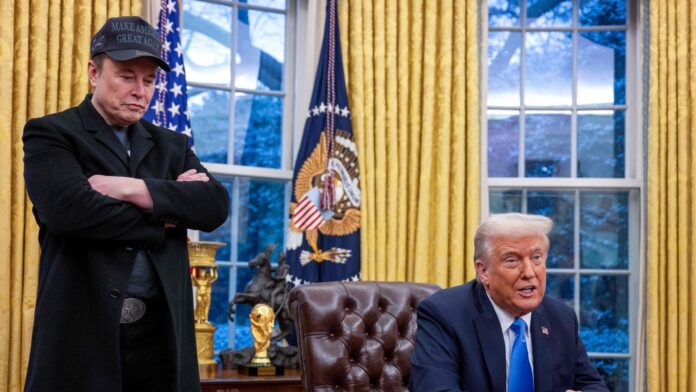The US operates on a fiscal year that goes from 1 October to 30 September. Its budget for fiscal year 2024-25 is likely to run a deficit of about $2 trillion on revenues of roughly $5 trillion (with outlays of above $7 trillion).
Also Read: US economy: Is stagflation making a comeback amid Trump turbulence?
To fund an ever-increasing deficit, which got materially worse after the covid pandemic, US federal debt has now touched 125% of gross domestic product (GDP), breaching its post-World War II high of 106%. The US national debt in 2025 will exceed $36 trillion at an average interest rate of about 3.3%, resulting in an annual debt-service requirement of about $1 trillion.
Alarmingly, this debt is growing at a faster rate than the US economy, implying that it is unlikely to shrink in relative terms anytime soon.
Enter the Department of Government Efficiency (DOGE). The stated goal of this extra-constitutional entity is to eliminate waste and fraud in the way the US government operates and in so doing cut the deficit in half (i.e., identify and eliminate $1 trillion of expenditure). As for tackling the other half of the deficit, the longer-term goal is to use deregulation and innovation to spur output growth, raising revenue and reducing the gap as a proportion of GDP.
Also Read: US government workers must brace for the wrath of DOGE
There exists an unofficial online tracker of DOGE’s activities, fed by what appears to be a remarkably close information source. In the one month since the start of DOGE, the Doge-tracker.com website shows $55 billion in savings on 1,200 activities. The biggest chunk of savings, at $6.5 billion, is shown as having come from the widely publicized USAID cuts.
While it is not possible to validate these measures, some of the activities that are listed on the tracker make for rather amusing reading. In a section called ‘Wasteful Taxpayer Funding (WTF)’ my favourites are $204,000 in savings from a “remote darting wild horse fertility program” and $2.7 million in savings related to an “NIH Study on Russian Cats Walking on Treadmills.”
While these actions invite headlines and may indeed identify wasteful spending and eliminate frivolous activities, they are unlikely to add up to a significant percentage of the US budget.
Also Read: It’s easy to guess why Trump has quit talking about inflation
The US constitution gives Congress the power to create a federal budget; this is in part the reason the budget year is not coincident with the beginning of a presidential term. The Congress’s budget is approved by the president, while the White House working with members of his party can propose bills that are consistent with his priorities. The budget itself is made up of two major parts: mandatory expenditure and discretionary spending. Congress decides the amount and type of the latter and provides resources for mandatory outlays.
Mandatory programmes are those that are required by law. These span entitlements, schemes for war veterans, etc, and are automatically available to those who meet their eligibility criteria. Medicare, Medicaid, Social Security and unemployment insurance are examples of these.
Over two-thirds of the US annual budget goes to mandatory programmes. In other words, on a spending base of $7 trillion, the overall portion that DOGE can consider for slashing without detailed Congressional collaboration is about $2.3 trillion, almost half of which must be clipped out if the goal of $1 trillion in expenditure cuts is to be met.
Also Read: Jonathan Levin: Trump fanned the inflation fears that haunt his presidency now
Discretionary outlays are determined each year by the president in consultation with Congress and typically refers to spending on defence, education and transportation. So, as a case in point, even within the discretionary category, it is difficult to imagine a 50% cut in defence expenditure.
Of course, in politics, being exact or literal is not the point. Success will be tracked by directional progress and the government’s ability to claim momentum. The unfortunate implication of this is that the US deficit is unlikely to reduce meaningfully, and the US national debt will inexorably increase as a proportion of GDP.
This does not augur well for US long bond rates, the dollar and the country’s sovereign credit rating in the long-term. But for the fact that the dollar remains unshakably the world’s reserve currency, a bond-market crisis would be inevitable, like the one that was triggered in the UK by its former prime minister Liz Truss’s unfunded tax cuts in 2022.
Also Read: We can’t expect budget tax cuts to boost GDP growth all that much
What lessons does DOGE have for countries like India?
Elimination of wasteful spending should be a periodic exercise in every democracy. On the expenditure side, any new welfare programme should be born with a sunset clause. It is better to review and renew a spending scheme than have it continue for decades. This will serve the cause of both efficiency and effectiveness. Once encrusted, budgetary expenditure is difficult to reduce. Fiscal goals such as ‘primary deficit elimination’ and budget balancing must return to favour.
P.S: “Keep only those things that speak to your heart. Then take the plunge and discard all the rest. By doing this, you can reset your life and embark on a new lifestyle,” said Marie Kondo, inspired by Shintoism.
The author is chairman, InKlude Labs. Read Narayan’s Mint columns at www.livemint.com/avisiblehand
#DOGE #dodge #debt #overload #problem
